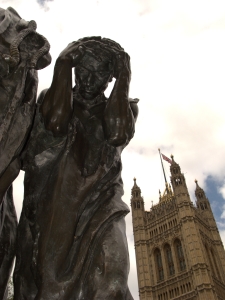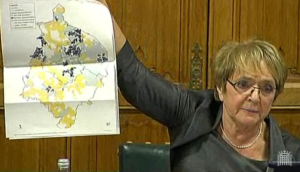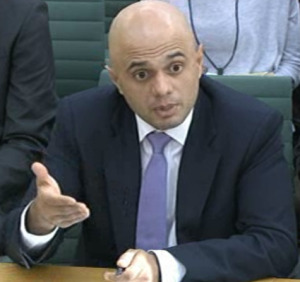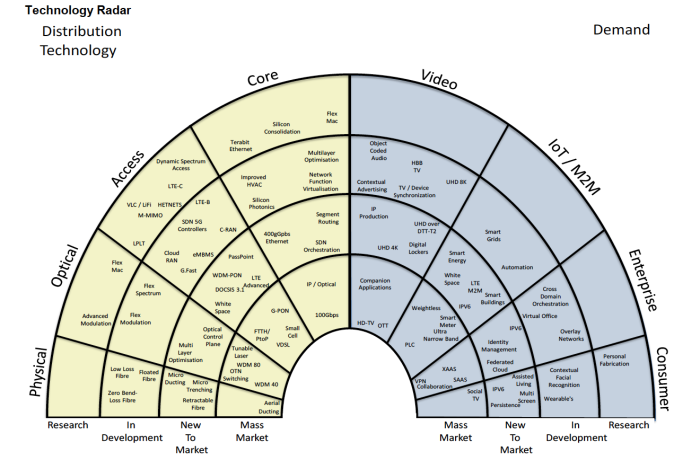Posts Tagged ‘broadband’
BT gets personal with PAC chair
Under pressure from the Public Accounts Committee to show value for money for the £1.7bn it is receiving for BDUK contracts, BT is fighting back.
Bill Broadband has just retweeted a Guido Fawkes tweet that it will “revisit” PAC chair Margaret Hodge’s tax affairs.
Bill Broadband is one of the names used by BT’s astroturf community to defend BT’s NGA roll-out and intimidate would-be competitors.
Hodge is away and unavailable for comment.
BT to cut BDUK roll-out costs – but it was already 20% cheaper
The National Audit Office (NAO) report on the BDUK’s former Rural Broadband Programme, now renamed the Superfast Broadband Programme, contains elements that might lead to cognitive dissonance.
It reports that BDUK commissioned Atkins, a primary supplier of services to government, to look at BT’s costs to provide high speed broadband in rural areas. After looking at a few sites in Suffolk, Atkins concluded “BT had charged Suffolk nearly 20% less than would hypothetically be charged by another efficient supplier, in part reflecting that BT benefits from substantial national bulk buying power compared with other providers.” Paragraph 3.10)
That’s good news, right? But it seems there’s more joy to come for taxpayers. In Paragraph 5 NAO reports “BDUK’s experience of actual costs in phase 1 has led to BT agreeing to submit lower costs in its financial model for phase 2.”
However, it carefully notes that BT was picking low hanging fruit in Phase 1, namely peri-urban areas rather than deep rural ones where is cost to reach them is likely to be higher, unless you use a satellite.
NAO also suggests BT got other sums wrong. BrOkenTeleph0n3 revealed that BT’s planners estimated BT would break even on a 20% take-up in 12-14 years. “Take-up of superfast broadband so far has been significantly faster than forecast by BT in the phase 1 contracts. Take-up has risen to more than 20% already for two non framework projects”, the NAO found. This “should bring greater coverage than contracted, as local bodies will be able to extend their rollout with remaining funds,” it says.
BT is the only framework supplier left, and 43 out of 47 county councils have opted to use the framework to procure Phase 2, although 10 may elect to hold money back for Phase 3, the final 5%.
“Overall, the effect of the first 2 phases will be to reinforce BT’s already strong position in the wholesale market for broadband infrastructure (the Wholesale Local Access Market). BT’s assets and infrastructure will benefit from approximately £1.7 billion of public sector investment although BT must maintain these assets at its own expense. BT is also required by regulatory conditions to provide wholesale access to other suppliers.”
The NAO also revealed that the public will benefit from clawbacks due to higher than expected take-up for only seven years. “After these seven years, the supplier will keep all of the extra wholesale profit.”
BT amortises its fibre over five to 20 years, and its exchange equipment over three to 13 years.
BTW, in its 2013 rural broadband report on page 35, the NAO said “The Atkins ‘should cost’ model for Northamptonshire is three per cent higher than BT’s actual bid for the area. Atkins was not able to complete analysis of a second local body area, Suffolk, due to the difficulties it encountered in modelling a more complex technical solution. Atkins’ model is the only model available to us that has tried to match a corresponding BT bid identically.”
The hour-long Public Accounts Committee interview on the NAO report, featuring DCMS, BDUK and BT officials, took place on 28 January 2015. You can see the video here.
PAC opens Act 3 of superfast broadband enquiry
There are still some people who are interested in seeing what’s happening to the near £2bn of taxpayers’ money given to BT to roll out next generation broadband in the “Final Third”. Many of them probably sit on the Commons’ Public Accounts Committee, which is taking its third stab at finding if BT is delivering value for money this coming Wednesday.
The PAC, chaired by Margaret Hodge, was previously frustrated by the answers it received (here and here), and vowed to keep asking questions until it was satisfied. BT’s director of strategy, policy and portfolio, Sean Williams, who was the source of much of Ms Hodge’s frustration, gets a third act in front of the committee.
Supporting players are DCMS boss Sue Owen, BDUK CEO Chris Townsend and superfast broadband programme director Andrew Field, and Openreach MD for infrastructure delivery Kim Mears.
In its preamble the PAC said its reports on the rural broadband programme in September 2013 and April 2014 “raised concerns over lack of published information on BT’s plans for superfast broadband coverage, the availability and transparency of cost data and the level of competition secured throughout the programme. This recall session will examine the transparency of cost and rollout information and explore whether the department has done enough to promote greater competition for phases 2 and 3 of the programme.”
The curtain for the hour-long show goes up at 2.15pm on Wednesday 28 January 2015, Committee Room 15, Palace of Westminster. If you can’t make it in person you can follow on Parliament TV: Rural broadband: progress update session.
Javid to break business broadband logjam?
The government is looking at how to get high speed broadband to urban businesses despite state aid rules that appear to preclude using some of the £2bn of BDUK money to do so, culture secretary Sajid Javid told MPs on the Culture, Media & Sport parliamentary committee yesterday.
Javid said DCMS is talking to stakeholders, including the Federation of Small Businesses, which this month produced a second damning report on broadband, to resolve the situation.
Javid also revealed that the contracts between BT and country councils for rolling out “superfast broadband” have claw-back clauses that come into effect when take-up reaches 20%.
Javid added that the government was updating the Electronic Communications Code as part of a deal with mobile network operators to extend mobile coverage to 90% of the UK land mass announced late last year.
The code was outdated and inconsistent with current technology and practice, he said. The required changes are included in the Infrastructure Bill currently before parliament (see here).
In February 2013 the Law Commission recommended changes to provide a clearer definition of the market value that landowners can charge for wayleaves, resolve inconsistencies with other legislation, clarify network upgrade and sharing rights, and establish the rights of land owners and network operators with respect to access to land and removal of equipment, as well as ways to resolve disputes
This link Culture secretary Sajid Javid on the DCMS annual report opens a new window. Javid’s comments on the code are at 12.43, and on broadband at 12.53.
MPs to query rural broadband roll-out

Some farmers who will be able to get their CAP forms in on time dug their own fibre in the B4RN area.
MPs have launched an inquiry into rural broadband speeds following on-going concerns that nearly £2bn of taxpayers’ money is unlikely to produce the expected results.
- the extent of broadband coverage in hardest to reach rural areas
- digital access and experience of digital─only programmes, such as the new CAP system applications
- support available for those required to use digital─only programmes
Written submissions should be submitted via the Rural broadband and digital─only services inquiry page on the Environment, Food and Rural Affairs website.
The deadline is Wednesday 19 November 2014.
What broadband network is fit for UK future? Have your say
There is less than a month left to respond to the government’s Digital Communications Infrastructure Strategy consultation.
The government seeks guidance on what people think will they require from a communications ecosystem that is fit for their purposes.
In preparing the consultation document it consulted “companies, organisations and individuals from across the communications industry, consumer representatives, the regulator, other government departments and the devolved administrations”.
A glance through Annex A shows that the consultation is, from the outset, framed by an insiders’ view of how the debate should go. “Our assumptions were developed through discussion with stakeholders and draw on a review of published reports and articles. The assumptions include:
- Users will need more bandwidth as data consumption continues to rise;
- Expectations to gain access to services and applications on the move will become the norm;
- Technological advances in telecommunications and broadcasting will continue to be rapid;
- We can expect changes in the communications market, potentially including new players and possibly market consolidation; and
- Resilience and reliability will become increasingly important as aspects of what constitutes a good service, alongside availability and speed.”
Last year the Confederation of British Industries (not credited) said in a study of the UK’s broadband infrastructure that it was “a mistake to hold back the investment until after the next election” and that “households and firms in rural internet ‘not-spots’ need to be connected faster”.
The Federation of Small Businesses (credited) said earlier this year the networks are not “fit for purpose”. “Many urban or semi-urban businesses can experience poor coverage too, and even where broadband is available the range and quality of services often fall short of what businesses require.
“Tailored business packages offering symmetrical upload and download speeds are often prohibitively expensive, while business parks and premises have been overlooked in the roll-out of local fibre networks to residential areas. If the full potential of small business is to be harnessed and the economic benefits of broadband connectivity realised, this must change.”
In 2012 the Forum of Private Business (credited) said, “Energy costs and access to effective telecommunications, including broadband, are the most important infrastructure issues faced by small businesses.”
To be fair, HMRC recently acceded to FPB’s call to delay the compulsory online submission of VAT and tax returns until there is adequate access to high speed broadband across the country.
But that is a small victory.
The well-connected Philip Virgo shows that the scenarios envisaged DCMS are already out of date. By 2020, DCMS’s most extreme view is likely to be commonplace, at least in other countries. Describing the background material as “myopic”, Virgo says, “…publicity for the consultation has been muted and its timing might seem to imply HMG is going through the motions and in not serious. But the politicians are serious and the consequences of a lack of response other than from those contacted will be profound.” (His emphasis.)
Virgo makes the point that the government’s ambition for government services to be “digital by default” is at odds with the delivery mechanism. For him there are two questions: are the on-line services of government usable by the target audience, and how is that usability measured?
As policy issues, those are a lot more useful than most of the 44 questions posed by the DCIS consultation (see Annex C for the summary.) Should government policy really consider technical issues like IPv6? Should it really care how UK network speeds compare to other countries?
A disciple of economist Michael Beesley, Virgo strongly believes that regulators can, or rather should, do little more than control price, quality of service and predatory behaviour. “The recent histories of Ofcom and Ofgem indicate why he was right,” he says.
The Rwandan telecoms regulator RURA has taken this to heart. Last year it set out easily understood and measured Quality of Service standards for mobile and fixed line operators. How the operators do it is up to them. Either they hit it or they don’t. At risk is their licence. That concentrates the mind.
But to return to the consultation. TechQT has put up the entire document plus annexes in an easily commentable online format, thanks to DigressIT. It will collect comments and forward them to DCMS by deadline. And it won’t “disappear” them the way inputs to the Digital Britain report have mysteriously vanished.
Comments close on 1 October. Have your say. It may be your last chance for 10 years.
UK’s £1.7bn broadband spend passes 1m homes; 13m to go?
Last week ministers claimed that the government’s £1.7bn budget has paid for superfast broadband to pass one million homes, so far.
This is 12% of the 8.8 million homes it is meant to serve with speeds above 24Mbps by 2017. As there appears to be no official source for the number of business premises, ministers are free to ad lib broadband availability to businesses.
There was no indication of what upload and download speeds users receive, and there are growing reports that services promised from some cabinets are now being deferred, perhaps indefinitely.
The money is all going to BT under the Broadband Delivery UK (BDUK) programme. It supplements the £2.5bn BT claims to have spent providing “superfast” service to the two-thirds of the population deemed “economically viable”, roughly the area covered by Virgin Media’s cable network.
A department of culture, media & sport spokesman said: “The £1.7bn is comprised of £1.2bn for phase 1 (£530m of BDUK funding plus local and European funding taking this up to £1.2bn) and £500m for phase 2 (£250m from BDUK to be matched by £250m further local and European funding).”
Based on the 2011 census, the Office for National Statistics (ONS) says there were 26.4 million households in the UK in 2013. Of these, 29% consisted of only one person and 20% had four or more people.
According to the department of business, innovation & skills, there were 4,895,655 UK businesses in 2013. Nor BIS, nor the ONS, nor the department of communities and local government (DCLG), which counts the cash raised from business rates, has a number for the physical shops, offices and factories businesses occupy.
That did not stop the Federation of Small Businesses last month from reporting that the national broadband network is unfit for business use. “The current government targets of 24Mbps for 95 per cent of the population and 2Mbps for the remaining five per cent will not meet the future demands of UK businesses.” it said. This includes video conferencing, remote back-ups and cloud applications.
This was tacitly confirmed by HMRC, which now allows firms in “remote locations” to submit their VAT returns by paper instead of online. FSB national chairman John Allan said the move will benefit many small businesses. “However, it clearly highlights the need for the government to tackle the poor state of digital infrastructure in the UK. Too many firms are negatively impacted by sub-standard broadband. It is vital business owners spend more energy doing business and less doing paperwork.”
There are also widespread reports that BT has deliberately ignored central business districts and business parks in both its commercial and taxpayer-subsidised broadband roll-outs. As a result, DCMS set up a £150m SuperConnected Cities fund that will give small business a £3,000 grant to upgrade their broadband connections in up to 22 cities.
The scheme was “red-lighted” In a Cabinet Office report in May 2013. A year later these cities had issued 1,008 vouchers.
Fixed to wireless connectivity was 77:23 with Virgin Media leading the list of suppliers followed by Metronet UK. DCMS said 149 suppliers had registered; 90 had won business as a result.
BDUK’s quarterly broadband performance indicator for June said the £72.4m BDUK has spent so far guaranteed at least 24Mbps download speeds to 888,133 premises. That is £81.56 per premises passed.
Put another way, the government is covering 12,260 premises for every million pounds spent so far. Ministers say they expect a £20 return on every pound spent on this roll-out.
Broadband is ‘national embarrassment’ – MP
Shoreditch MP Meg Hillier is to hold a Broadband Roundtable at 10am on 31 July at Perseverance Works in Shoreditch, the heart of London’s TechCity district, to discuss the “embarrassing” availability of broadband in central business districts, never mind rural areas.
So far 422 suppliers have registered to service the government’s £150m Urban Broadband Fund, which funds the SuperConnected Cities scheme. Some 149 have have provided quotations, and 90 have won business, says DCMS.
By the end of May the cities had issued 1008 vouchers in 14 months. The fixed/wireless connectivity split was 77/23 per cent, and the average speed per connection went from 11.2Mbps to 70.3Mbps for downloads.
According to Hillier’s blurb, “Broadband is a national embarrassment and action is urgently needed. Government grants of £3,000 have been added in, but that is like a sticking plaster on a broken arm. Businesses are moving out of the area because they simply cannot access high speeds.”
The cities in the SCC programme are Aberdeen, Belfast, Birmingham, Bradford, Brighton and Hove, Bristol, Cambridge, Cardiff, Coventry, Derby, Derry/Londonderry, Edinburgh, Leeds, London, Manchester, Newcastle, Newport, Oxford, Perth, Portsmouth, Salford, and York.
DCMS says it will provide a city by city breakdown “this summer”, but declines to say how much money has been paid out so far or to whom. However, Virgin Media tops a DCMS table of suppliers to whom vouchers have been issued (see below).
BT, which Ofcom says has an effective monopoly on wholesale fixed line access despite Virgin Media’s efforts, declines to say how many vouchers it has won. Its Openreach division is likely to be a big winner anyway. This is because smaller operators like Hyperoptic and TalkTalk rent ducts and lines from Openreach, even as BT’s Business division competes with them at a retail level.
So does 1,008 vouchers issued in 14 months represent success or failure? To be fair, it’s probably too soon to tell, but there’s not much time left – DCMS says the money dries up in March 2015.
It’s appropriate that Perseverance Works (PW) is the venue. Helped by former BDUK consultant Mike Kiely, the firm has just contracted Fibre Options to supply a 16Gbps link into the premises which houses around 90 businesses.
As landlord, PW will own the network. Each tenant will be able to use the government vouchers to order a connection running at up to 1Gbps. Fibre Options will do the provisioning and billing.
It took more than a year to negotiate the deal because the usual suspects were not prepared to consider an aggregated customer base – they wanted to sell a long-term leased line service that most tenants neither wanted nor could afford. PW eventually went to tender, which Fibre Options won.
PW spokesman Paul King says he sees “no reason” why PW’s approach should not be replicated by business parks across the country. Members of INCA are currently targeting business parks, most of which have been neglected in BT’s NGA roll-out.
The details again: 10:00-11:00, Thursday 31 July, 2014 at Eastside Educational Trust, Suite 16, Perseverance Works, 37 Hackney Road, E2 7NX. To book a place call Meg Hiller’s office at 0207 219 5325.
ISPs cash in on voucher scheme
| 1 | Virgin Media Business |
| 2 | Metronet (UK) |
| 3 | Spectrum Internet |
| 4 | AQL |
| 5 | Unitel One Source Ltd |
| 6 | Tibus |
| 7 | CFL |
| 8 | Atlas Communications |
| 9 | Venus Business Communications |
| 10 | ITC |
| 11 | BT plc |
| 12 | Optimity |
| 13 | Unique Network Solutions |
| 14 | Qubic Group Plc |
| 15 | Exponential-e Ltd |
| Source: DCMS |
How freedom DRIPs away
We don’t normally move away from broadband, but this is a worthy exception because it bears on the kind of society that access to broadband opens up.
Last April the European Court of Justice struck down the Data Retention Directive . This is the basic European legislation that allows governments to implement legislation that enables them to collect, store and share communications data. The ECJ said it was too broad and there were too few safeguards to protect against abuse of the privilege.
This meant that the UK’s mass surveillance of its citizens’ communications lacked a legal basis. The Home Office told ISPs (which ones is secret) to continue to collect, store and share this data on demand with up to tens of thousands of public sector workers under the RIPA law. Privacy groups started court proceedings against the ISPs.
The government last week introduced primary legislation it said would restore its powers, nothing more. Now legal academics have challenged that view.
Paul Bernal, a professor at East Anglia, has published an open letter to MPs and lords calling for considered debate of the Data Retention and Investigatory Powers Bill (DRIP) and a halt to the “emergency” rush to turn the bill into law tomorrow.
“In fact, the Bill proposes to extend investigatory powers considerably, increasing the British government’s capabilities to access both communications data and content. The legislation goes far beyond simply authorising data retention in the UK. In fact, DRIP attempts to extend the territorial reach of the British interception powers, expanding the UK’s ability to mandate the interception of communications content across the globe. It introduces powers that are not only completely novel in the United Kingdom, they are some of the first of their kind globally.”
If passed the bill will give legal cover to the mass surveillance activities of GCHQ and the NSA exposed by the Snowden revelations.
Most European countries have either not implemented the Data Retention Directive (Germany decided it breached their constitution) or have struck down their enabling legislation to comply with the ECJ’s decision.
Bell Labs turns copper to gold – not
Bell Labs, which more or less invented the communications network business, has just given a new lease of life to copper network. In theory.
Its researchers have achieved speeds of 10Gbps over a pair of twisted copper lines in the lab. They have also got them to deliver 1Gbps symmetrical broadband, again in the lab.
That sounds like BT (in fact pretty much all incumbent telcos) is justified in pursuing its fully-depreciated investment in copper wires instead of switching to cheaper to operate fibre.
But the good engineers at Bell Labs also published a number of caveats.This is short distance technology. “The XG-FAST technology can deliver 1Gbps symmetrical services over 70m (for the cable being tested). This was achieved using a frequency range of 350MHz. Signals at higher frequencies were completely attenuated after 70m.”
So that’s it; 70m is the distance limit for gigabit copper.
But there’s more. “In practical situations, other significant factors that can influence actual speeds (not taken into account during these tests but which have been studied extensively elsewhere) include the quality and thickness of the copper cable and cross-talk between adjacent cables (which can be removed by vectoring),” they say.
They also published this handy guide for operators who are trying to match the exponentiating demand for bandwidth against their budgets for switching to fibre. It makes a trenchant leave-behind when you discuss the provision of high speed broadband with your local councillors and MPs as we approach the upcoming elections.
During testing, Bell Labs showed that
|
Technology comparison |
|||
|
Technology |
Frequency |
Maximum aggregate speed |
Maximum Distance |
| VDSL2* |
17MHz |
150Mbps |
400m |
| G.fast phase 1* |
106MHz |
700Mbps |
100m |
| G.fast phase 2* |
212MHz |
1.25Gbps |
70m |
| Bell Labs XG-FAST** |
350MHz |
2Gbps (1Gbps symmetrical) |
70m |
| Bell Labs XG-FAST with bonding*** |
500MHz |
10Gbps (two pairs) |
30m |
* Industry standard specifications. G.fast allows for upload and download speeds to be configured by the operator.
** In a laboratory, reproducing real-world conditions of distance and copper quality.
*** Laboratory conditions.






